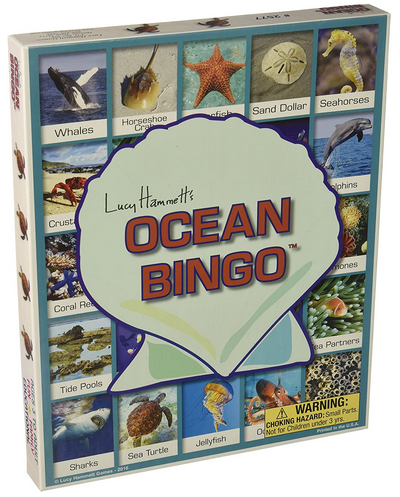 |
| Ocean Bingo |
I have gotten into the habit of playing a game of bingo with one of my families at the end of our sessions. It's actually a pretty good way to teach if you are using a picture bingo. Kids will learn to recognize things by name and picture. We have been using my Animal Bingo. The young man has learned all 48 animals, so our next adventure is Ocean Bingo. Ocean Bingo is a little different because it does not deal with just animals, but other ocean related things, such as islands, tides, the Titanic, pearls and a water cycle.
There are 6 bingo cards and they measure 8.5" x 11". The cards have a 5 X 5 grid with a free spot in the middle. The cards are a card stock and can easily be laminated to hold up longer.
There are 42 calling cards. Each card has a picture and a word description on the front and information about that item on the back.
The markers are on a perforated card stock and you need to tear them apart before you play.
There is also a line of bingo cards called Jingo. They offer information with each calling card, instead of just a number or picture only. I have blogged about several of them including Community Jingo, Money Jingo and Thanksgiving Jingo. Click here to check them out.
Object:
Be the first to get 5 in a row in any direction: horizontal, vertical or diagonal. Or use another pattern, such as fill in the border or make a letter X, etc.
Set up:
Give each person playing a BINGO card and several markers. Choose a person to be the caller. Mix the calling cards face-down and give them to him.
Play:
The caller will turn over one card and call it. All players will put a marker on that square if they have that animal on their card. The caller repeats this until someone matches the winning pattern on his card and yells BINGO. Check the player's card for accuracy and reward the prize if there is one. Play again.
Try this:
- Practice recognizing a winning pattern before playing. Cover a pattern with markers on a card so the individual can see what it will look like. Then set up several cards with multiple markers and a win embedded on each one and ask the player to find it. Work until he is proficient at spotting the winning pattern.
- Watch for only one BINGO direction at a time until they are used to watching for it (horizontal, diagonal, vertical). Then watch for two directions, then for three. Then try a bingo in any direction.
- Place the call out card next to the player's BINGO game card if he needs it to compare to the animals on his card.
- Ask the player to repeat each animal name as they cover it with the marker.
- Ask player's to hold several marker pieces in their dominant hand as they play. Ask them to bring the pieces to the fingertips, one at a time, and place on the card as they play. Use a variety of things as markers to practice with different items, such as paper clips, coins or dried beans, etc.
- Use letters as your patterns. You can play for O (border), X, N, L, P, C, E, F, G, H, I, S, T, U, Y and Z.
- Display a black and white card with the BINGO pattern for each game highlighted in yellow so the players can remember the pattern they are looking for. You can just make them with a black marker on white paper or draw them on the board.
- Visualize the letter you are going for as a bingo and do not mark pictures that aren't part of the letter.
- Pick the pieces off the cards after each game, squirreling them in the palm as you go. How many can you hold without dropping?
- Stop occasionally and check the player's card. Ask them to point out places where they only need one more to win a bingo. Or point out possible bingos and ask how many more will be needed to win or which squares will need markers to win in that direction etc.
- Display a black and white card with the BINGO pattern for each game. You can just make them with a black marker on white paper or draw them on the board.
- Work on visual discrimination, figure ground, visual closure, eye-hand coordination, fine motor, in-hand manipulation, manual dexterity, executive functioning skills, socialization skills, process skills, play and leisure exploration and participation
In the box: 6 bingo cards, 42 calling cards, markers
If you are interested in purchasing this game or just want more information, click on the image below.




